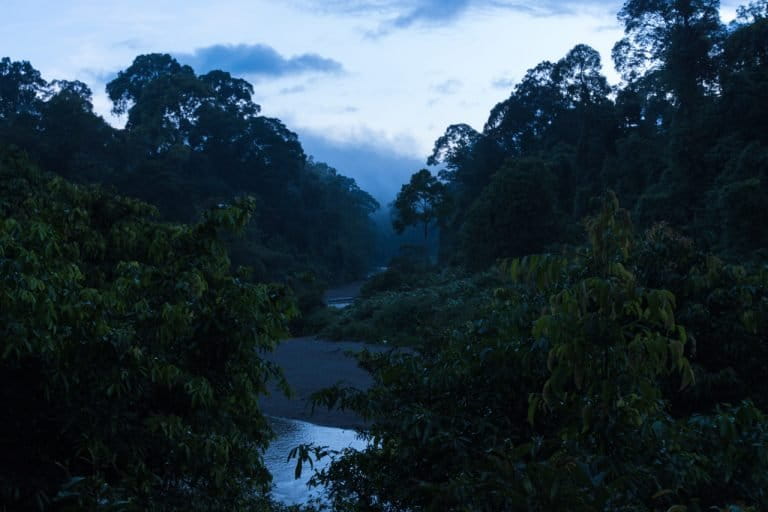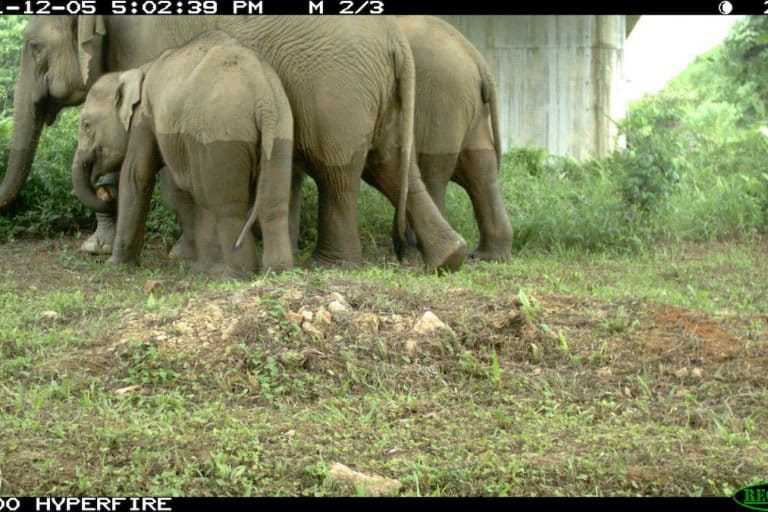- Southeast Asia is one of the epicenters of a global “tsunami” of infrastructure development.
- As the countries in the region work to elevate their economic standing, concerns from scientists and NGOs highlight the potential pitfalls in the form of environmental degradation and destruction that roads, dams and other infrastructure can bring in tow.
- Mongabay had reporters covering the region in 2017. Here are 10 of their stories.
Around the world, there’s a push for rapid infrastructure development, and nowhere is that truer than in Southeast Asia. Roads, seen by the World Bank as a “blunt instrument” for economic development, are perhaps the most visible sign of this coming storm, with 25 million kilometers (15.5 million miles) of roads slated for construction around the world by 2050. In Southeast Asia, local, regional and national governments are working on projects like the Pan-Borneo Highway, the Central Spine road to connect Kunming in China with Singapore, and the expansion of roadways to link small communities with big cities.
While research doesn’t always show a firm connection between these developments and immediate economic benefits, poorly sited roads have been shown to open once-remote areas to hunting, agriculture and human settlement. Countries around the region are also working on dams for drinking water and hydroelectric power, railroads to shoulder the traffic burden from a growing population, and even new land created by pulling up sand and gravel from the sea floor.
Throughout 2017, Mongabay’s staff and contributors have been talking with the scientists, community leaders and government officials involved in the decision-making process. And they’ve spent time on the ground working to understand the important impacts on the environment and the lives of the people who call these places home. As the year draws to a close, here’s a look back at 10 important stories on infrastructure in Southeast Asia from 2017.

1. An ‘infrastructure tsunami’ for Asia: Q&A with researcher William Laurance — Jan. 6, 2017
Tropical ecologist William Laurance spoke with series editor Isabel Esterman about a “tsunami” of new development happening all over the world. In 2014, he and his team put together a global roadmap highlighting spots where roads could do the most environmental damage and others where they could help connect farmers to markets and benefit local economies. Since that time, the researchers, based at James Cook University in Cairns, Australia, have focused their efforts on Southeast Asia. They’re gathering finer-scale data about upcoming projects, creating relationships with NGOs, other scientists and government officials, and working to identify the environmental, social and economic costs of planned projects across a region replete with critically important tropical habitats.

2. Thap Lan: Thailand’s unsung forest gem under threat, but still abrim with life — Jan. 31, 2017
Thap Lan National Park in Thailand is a bastion of biodiversity in Southeast Asia, providing a home for 112 species of mammals, 392 species of birds and 200 species of reptiles and amphibians. Asian elephants (Elephas maximas), king cobras (Ophiophagus hannah) and hornbills are all found in the park’s 2,236 square kilometers (863 square miles) of forest, and it’s a UNESCO World Heritage Site. But in addition to poaching and logging, the expansion of a highway that connects to Bangkok is encroaching on the park. Officials argue that a wider road is vital to the country’s development, and there are plans for wildlife corridors to allow animals to move around in the park. But conservationists worry that it’s not enough. Journalist Demelza Stokes takes us into the park for a look at how Thailand is working to balance conservation with economic development.

3. Rio Tinto walks away from environmental responsibility for Bougainville’s Panguna mine — April 6, 2017
Local communities on an island in eastern Papua New Guinea are still dealing with the negative effects of a copper mine decades after it was shut down. In 1989, local landowners succeed in halting Rio Tinto’s operations at the Panguna open-pit mine, arguing that the company was polluting the local water supply and hadn’t adequately shared its profits. The government is trying to get Rio Tinto to fund a cleanup operation, but the company said that, since 2016, it no longer has a financial stake in the mine and therefore can’t be held responsible. Contributor Catherine Wilson sifts through the arguments for Mongabay.

4. On the road to ‘smart development’ — May 25, 2017
Critical questions about where to build roads and other infrastructure projects swirl in places like Malaysia, not just about the locations that will do the least environmental harm, but also where they’ll bring about the most social and economic good for local people. But the benefits are often overblown and the costs underestimated, said ecologist Bill Laurance as he and his team embarked on a new project in 2017. Their aim is to help policymakers get hold of the kind of data that puts those highly complex decisions in the simplest terms, allowing for infrastructure development that does the most good and the least harm. Staff writer John Cannon tagged along with Laurance and his colleagues on a recent trip to Malaysia and filed a dispatch in May.

5. Sand mining, land reclamation meet fierce resistance in Makassar — July 10, 2017
The government of the Indonesian province of South Sulawesi is intent on creating more space and a new “prestigious landmark” in the form of a series of artificial islands off its capital city, Makassar. The land-reclamation project needs 22 million cubic meters (777 million cubic feet) of sand and gravel, which has spurred local fishing communities into a campaign of resistance. They say the plunder of that much building material will crush their livelihoods, so they’ve tried to block dredging ships. A local NGO has also sued the government for not having a fisheries permit or an environmental impact assessment. Reporters Rahmat Hardiansya and Wahyu Chandra visited Makassar to get the full story.

6. Road projects threaten Sumatra’s last great rainforests — Aug. 7, 2017
Often seen as a simple tool to bring quick economic benefits, roads also open up remote areas to environmental degradation and destruction. In 2017, officials on the Indonesian island of Sumatra moved forward plans to build a network of roads designed to connect local communities and provide evacuation routes from far-flung areas. But conservationists opposed blueprints to cut into several national parks on the island. These parks hold around 10,000 plant species and more than 200 mammal species, including the critically endangered Sumatran orangutan, which could suffer due to the acceleration of habitat loss that roads could introduce into their ranges. Staff writer Hans Nicholas Jong investigates for Mongabay.

7. Malaysia’s East Coast Rail Link a double-edged sword for environment, wildlife — Aug. 9, 2017
In August, crews in Peninsular Malaysia started working on a new 600-kilometer (373-mile) railroad that will connect this part of the country’s east and west coasts. Funding for the $12.8 billion effort is coming from Chinese backers, and it’s hoped that the railway will ease the traffic burden on Malaysia’s roads. But it also cuts through important areas of forest and critical habitat for the region’s wildlife. The environmental impact assessment for the project reports that it will cause “severe fragmentation of habitats.” Contributor Kate Mayberry traveled to the area and tells the story for Mongabay.

8. ‘Ecological disaster’: controversial bridge puts East Kalimantan’s green commitment to the test — Aug. 30, 2017
The Indonesian province of East Kalimantan is working to connect its cities to more rural parts of Borneo in an effort to jump-start the economy. Currently, crews are working on the Pulau Balang Bridge to link Balikpapan with communities across Balikpapan Bay. In the works for nearly a decade, the project has raised the ire of conservationists worried about the damage the bridge might do to marine life in the bay and the wildlife within the remaining tracts of primary coastal forest. And local community members worry that the economic development promised by the government will go unrealized. Staff writer Basten Gokkon tells the story.

9. Cross currents: Mega-dams and micro-hydro offer two different futures for rural Borneo — Sept. 20, 2017
Residents of villages along the Papar River in northern Borneo face an uncertain future. In January 2017, the infrastructure minister of the Malaysian state of Sabah announced that plans were moving forward to build the long-planned Kaiduan Dam to provide drinking water to people living in the state capital, Kota Kinabalu. But construction of the dam would require resettling several villages in the area. In the meantime, villages such as Longkogungan are installing their own infrastructure in the form of micro-hydropower systems to harvest energy as streams tumble through the mountains of the Crocker Range toward the sea. Reporter Kenny Gotlieb met with local leaders and shares their stories.

10. ‘If it’s going to kill us, OK, we’ll die’: Villagers stand firm as Cambodian dam begins to fill — Oct. 18, 2017
Crews in Cambodia started construction of a new dam in September. The $800 million project will be the country’s largest generator of hydropower, but NGOs argue that the thousands of lives it will affect are too high a price to pay. They contend that losses to fishing communities both upstream and downstream of the dam will be disastrous. The government has already resettled many communities, but contributor Jenny Denton reports that 100 families have resolved to stay on their land, even as the waters rise around them.
Editor’s note: William Laurance is a member of Mongabay’s advisory board.
Banner image of Bornean orangutans by John C. Cannon.
FEEDBACK: Use this form to send a message to the author of this post. If you want to post a public comment, you can do that at the bottom of the page.














